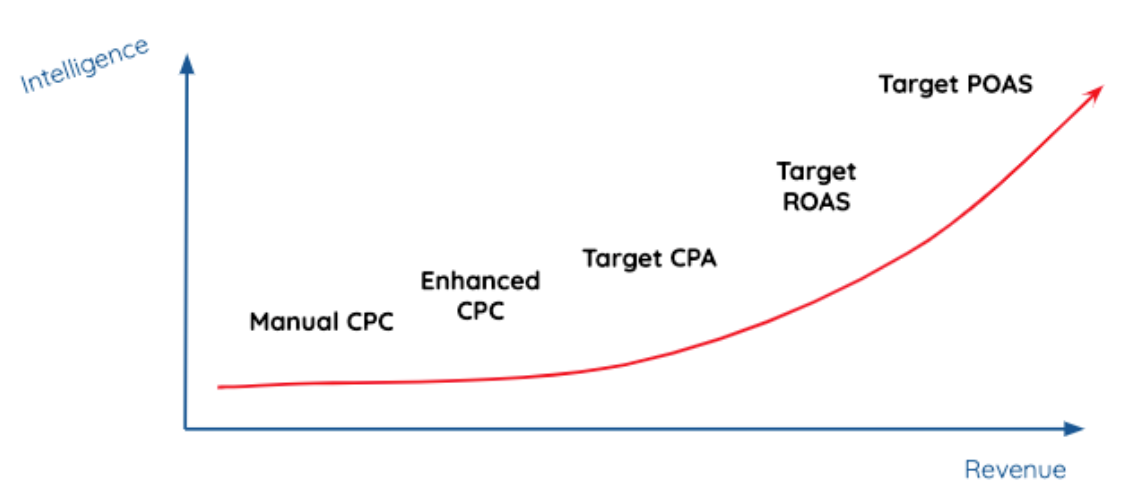Profit Margin Bidding.
Optimizing your Google accounts based on profit data.
It seems the logical next step in Smart bidding optimization.

The idea behind Google Ads advertising is simple:
You invest in order to get a sale (or any other type of conversion).
It should quickly become clear if Google Ads is a channel that might be interesting (read: profitable) for you.
Very roughly, just for the purpose of the argument:
Let’s say your website's average conversion rate is 1%.
This implies that you need 100 sessions on your website to generate 1 sale.
Assume you want to use Google Ads to bring you these 100 sessions.
And you foresee that the average CPC is 1 euro (lets pretend that clicks = sessions).
You will indeed invest 100 euro to drive 1 sale.
If you are now selling a product with a profit value below 100 euro. You are making a loss.
Moreover, it could very well be that Google Ads might not be a profitable channel for you.
It’s often surprising the CPC (cost per click) that some are paying. Wondering if they actually have any idea of their profitability. Probably, it's often not the case. And there might be some good reasons for that. Here, we are for example not taking into account Customer Lifetime Value, Branding objectives, Offline Conversions, and a whole range of other (important) elements.
Back to Google Ads, and how to get the most value out of it. Smart bidding strategies: Maximize Revenue, tCPA and tROAS are designed to ensure that you reach your targets in terms of Revenue maximization, Cost per Acquisition or Return on Ad Spend.
It is great if you can deliver a ROAS of 10 with such a Smart Strategy.
It implies that for every euro spent 10 euros in revenue are generated.
However, we reckon that a great ROAS often isn’t convincing enough to further scale digital initiatives.
What you need to be able to say is:
For every euro spent, X euro in PROFIT is generated. Enter: POAS (Profit over Ad Spend).
In theory, the idea is simple. If you would have a POAS of 2, you should get unlimited resources because it just makes sense. For every euro spent, you get back 2 euros. With that kind of deal, you would go ‘ALL-IN’.
Optimizing towards profit in Google Ads
Getting the profit in your Google Ads account is not straightforward.
Actually, in Belgium it has never been done before in an automated way at this scale. Another Semetis #innovation.
In collaboration with our client, and dedicated support from Google Specialists, we managed to inject the profit data in Google Ads. Today, we have a view on the profit generated by our Google Ads campaigns (Shopping & Search). We hence also have a view on the POAS (Profit over Ad Spend). We can report on profitability.
Moreover, next to reporting, we also leverage the data for Smarter bidding. Getting the profit data in your Google Ads account, also allows you to use different optimizations strategies. Instead of ‘maximize Revenue’ you could choose to use a ‘maximize Profit’ Smart Bidding Strategy.
With the ‘maximize Profit’ strategy, our Google Ads is automatically optimizing on maximizing the profit within our media budget by taking into account all the signals behind the Smart Bidding Google Algorithm (the actual search query, time, location, device, 1st party audience list, …).
Revenue or Profit ?
Whether you actually choose to optimize towards revenue or profit is a completely different discussion. There are arguments for both options.
On one end, focussing on profitability would ensure that your digital initiatives are bringing you more profit. However, you might become more conservative in terms of investing as you wish to reach or protect a certain profit. Therefore, consider that short term profitability should not always be aspired. In this reflection, it is important to take into account the above mentioned elements such as: CLTV, Offline Conversions, Branding Impact, ...
On the other hand, focussing on revenue ensures that you further expand your market share. This might imply that you would be less profitable, but you are growing and securing market share.
The potential pitfall is to focus on one of these two metrics. In our opinion, the true value of this ‘Profit Margin Bidding’ project is that we finally actually have a view on our profitability.
You need to find a balance between being profitable and expanding your market share.
The complete set-up of the profit margin bidding goes beyond the scope of this article. We are planning a follow-up article in which we will unravel the process.
At the end of the day, we all want to make profit.
Extra comments:
- Obviously, we are aware that the profit we are using is gross profit and hence not net profit. Nevertheless, the case is already much stronger when reporting on Gross Profit than when reporting on Revenue.
- We are not saying that all Google Ads endeavours need to be profitable on the first touch. But in many cases, and for many clients, that is the expectation.
